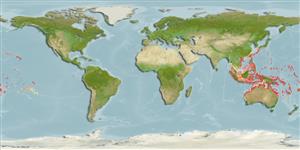>
Eupercaria/misc (Various families in series Eupercaria) >
Labridae (Wrasses) > Corinae
Etymology: Halichoeres: Greek, als, alis = salt + Greek, choiros = pig (Ref. 45335).
More on authors: Quoy & Gaimard.
Environment: milieu / climate zone / depth range / distribution range
Ecologia
marinhas associadas(os) a recifes; intervalo de profundidade 2 - 30 m (Ref. 48636), usually 2 - 18 m (Ref. 89972). Tropical; 30°N - 32°S
Indo-Pacific: Christmas Island and Rowly Shoals in the eastern Indian Ocean to the Line and Ducie islands, north to south Japan, south to Lord Howe Island.
Tamanho / Peso / Idade
Maturity: Lm ? range ? - ? cm
Max length : 27.0 cm TL macho/indeterminado; (Ref. 9710)
Espinhos dorsais (total): 9; Raios dorsais moles (total): 11; Espinhos anais 3; Raios anais moles: 10 - 11. Light greenish to yellowish on back, white below; scale rims pink to blackish; a black spot is at the upper base of the pectoral fin; another black spot about equal to eye diameter is at the upper base of the caudal peduncle.
Inhabits sandy areas of reef flats, lagoons, and semi-protected seaward reefs. Juveniles shallow in protected coastal waters; adults to about 30 m depth (Ref. 48636). Feeds on sand and rubble dwelling invertebrates (crustaceans, mollusks, forams, polychaetes, fish eggs, and small fishes). Has the habit of following sand-disturbing fishes such as goatfishes in order to intercept escaping prey. Minimum depth reported taken from Ref. 30874.
Life cycle and mating behavior
Maturidade | Reprodução | Desova | Ovos | Fecundidade | Larvas
Bi-directional sex change has been confirmed for this species (Ref. 103751). Distinct pairing during breeding (Ref. 205).
Randall, J.E., G.R. Allen and R.C. Steene, 1990. Fishes of the Great Barrier Reef and Coral Sea. University of Hawaii Press, Honolulu, Hawaii. 506 p. (Ref. 2334)
Categoria na Lista Vermelha da IUCN (Ref. 130435)
Ameaça para o homem
Harmless
Utilização humana
Aquário: Espécies comerciais
Mais informação
ReferênciasAquaculturaPerfil para aquaculturaEstirpesGenéticaElectrophoresesHereditariedadeDoençasProcessamentoNutrientsMass conversion
Ferramentas
Relatórios especiais
Descarregue XML
Fontes da internet
Estimates based on models
Preferred temperature (Ref.
123201): 24.7 - 29.3, mean 28.4 °C (based on 2136 cells).
Phylogenetic diversity index (Ref.
82804): PD
50 = 0.5000 [Uniqueness, from 0.5 = low to 2.0 = high].
Bayesian length-weight: a=0.01000 (0.00623 - 0.01606), b=3.00 (2.87 - 3.13), in cm total length, based on LWR estimates for this species & Genus-body shape (Ref.
93245).
Nível Trófico (Ref.
69278): 3.5 ±0.51 se; based on food items.
Resiliência (Ref.
120179): Médio, tempo mínimo de duplicação da população 1,4 - 4,4 anos (Preliminary K or Fecundity.).
Fishing Vulnerability (Ref.
59153): Low vulnerability (17 of 100).
Nutrients (Ref.
124155): Calcium = 57.9 [35.4, 92.7] mg/100g; Iron = 0.608 [0.360, 1.098] mg/100g; Protein = 18.6 [15.7, 20.7] %; Omega3 = 0.141 [0.095, 0.211] g/100g; Selenium = 25.8 [16.3, 44.2] μg/100g; VitaminA = 119 [38, 421] μg/100g; Zinc = 1.45 [1.04, 2.25] mg/100g (wet weight);
